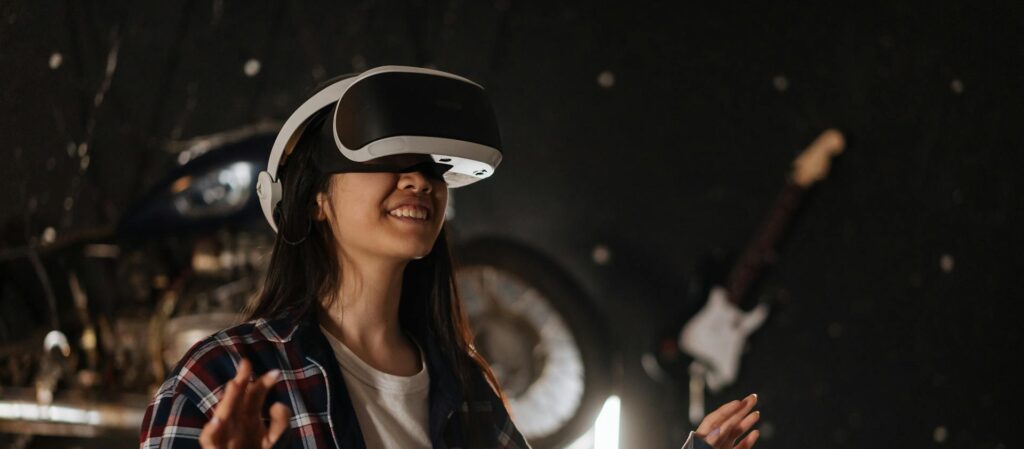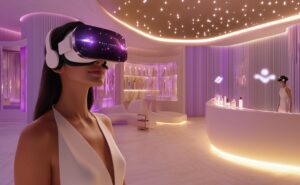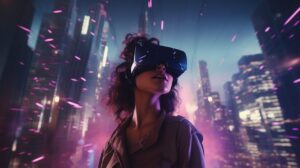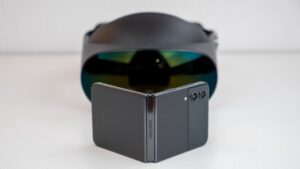Like every other global business environment, the advertising industry faces profound transformations due to the introduction of advanced technologies disrupting the boundaries of traditional approaches. Augmented Reality is a powerful example of reshaping how brands connect with their audiences. Instead of pushing messages, nowadays, companies prefer to develop immersive experiences, inviting users to explore, interact, and remember a brand’s product, service, and image. In the following sections, we’ll discover the potential of AR Marketing and how it enhances customer engagement by turning observers into active participants.
What Is Augmented Reality Marketing?
Augmented Reality in marketing campaigns uses digital technology to overlay virtual elements onto the real world, accessed via smartphones, tablets, or wearable devices. Augmented and Virtual Reality advertising enables brands to display 3D models, animations, games, or interactive information within physical environments without requiring specialized equipment.
Different from most traditional formats, Augmented Reality advertising campaigns are contextual and responsive, adapting to user interactions and surroundings. Whether a customer is trying on sneakers through their phone or scanning a product box to unlock a game, Augmented Reality marketing turns promotional content into detailed, immersive experiences.
Why Augmented Reality Advertising Boosts Customer Engagement
Augmented Reality marketing campaigns aren’t just visually impressive. They fundamentally transformed the way customers interact with brands thanks to specific strategic reasons that boost engagement better than traditional or digital-first media approaches, such as:
Sensory Engagement and Memory Retention
AR introduces multi-sensory interaction, developing an elevated level of simulations to activate more areas of the brain, making the experience more immersive and memorable. Studies reveal that people retain much more information from interactive AR experiences than from flat media, making AR advertising an ideal tool for brands that want their message to remain, regardless of the dynamism of today’s digital environments.
Personalization and Emotional Resonance
Augmented and Virtual Reality marketing campaigns can adapt in real-time based on user preferences, behavior, or environment, providing a sense of one-on-one communication with the brand. This type of content allows users to see themselves using and wearing products, creating emotional resonance, which has been proven to increase purchase intent and long-term loyalty.
Shareability and Viral Potential
AR marketing provides funny, surprising, and visually unique experiences, making them ideal for social sharing. Unlike passive ads, AR advertising encourages users to capture, save, and post their interactions on social media, turning them into brand ambassadors. This UGC extends campaign reach, generating thousands of impressions at a fraction of the cost of paid media.
Augmented Reality Marketing Examples and Main Applications
Augmented Reality marketing is being adopted across various industries to solve different challenges. From improving shopping experiences to amplifying entertainment. Among the main applications of AR advertising, we can mention:
🛒 AR Retail Experiences
Augmented Reality has revolutionized how consumers evaluate products, from AR furniture apps that let users visualize sofas in their living rooms to virtual try-ons presented by brands like Sephora and Ray-Ban to test-fit the products before purchasing them.
🎸 Events And Music: Enhanced Live Moments
Live events have become playgrounds for immersive AR marketing campaigns. YORD’s WebAR Concert for Tatra Banka’s Bejby Blue allowed fans to experience a performance overlaid on real-world locations via smartphones, thanks to Augmented and Virtual Reality marketing content that fosters emotional intensity, especially when combined with live sharing, leading to stronger brand affinity and recall.
👕 Augmented Reality Merch
Static merchandise and promotional materials are evolving. YORD’s AR-enhanced business cards, posters, and clothing convert physical items into interactive digital portals like the one developed for the SkodaVerse initiative. Whether scanning a t-shirt to unlock a product video or using AR to view a business card’s portfolio, these activations offer brands a low-cost, high-impact way to extend engagement beyond the physical world.
🕹️ Gamified Experiences
Gamification in AR uses game mechanics like rewards, challenges, and real-time feedback to encourage exploration. From branded treasure hunts to mini games triggered by scanning a product, these experiences transform AR advertising campaigns into entertainment solutions.
📱 Augmented Reality Filters on Social Media
Platforms like Instagram and TikTok are amazing grounds for AR-driven content. Branded face filters, 3D overlays, and interactive effects engage users directly where they spend time, and with features they love to share. YORD’s AR filters for L’Oréal allowed users to test products, enter giveaways, or unlock exclusive content, boosting engagement and increasing conversions.
The Benefits of Augmented Reality in Marketing
AR marketing doesn’t just captivate; it also delivers measurable business impact. While the immersive nature of AR creates memorable experiences, its real strength lies in how it converts engagement into tangible outcomes for brands. Among the core benefits that demonstrate why AR is becoming the key to modern marketing strategies, we can find:
Increased Time Spent with the Brand
One of AR’s most immediate impacts is its ability to hold user attention far longer than traditional ads. AR encourages exploration and interaction, with users spending 2 to 3 times more time engaging with AR campaigns than with static visuals or video content. AR marketing gives brands more opportunities to communicate value, tell stories, and build emotional connections during critical customer journeys.
Higher Conversion Rates through Confidence and Interactivity
AR marketing empowers customers to make more informed and confident purchasing decisions by allowing them to visualize, test, or explore products in real time. AR-driven campaigns allow customers to virtually place a sofa in a living room or try on a lipstick shade through a filter, developing a stronger sense of certainty and satisfaction before buying.
Viral Reach and User-Generated Content
AR naturally inspires users to share their experiences, mainly when campaigns include filters, gamified elements, or unique visuals. This user-generated content becomes a powerful organic marketing engine, each post serving as an authentic brand endorsement.
The Future of Augmented Reality Marketing Campaigns
The convergence of Artificial Intelligence into Virtual and Augmented Reality marketing opens new frontiers. With devices like Apple Vision Pro and Meta’s Ray-Ban smart glasses, AR advertising will become ambient and embedded in daily life. Intelligent agents will deliver adaptive content based on mood, preferences, and context, making AR ads as natural as scrolling a feed. From AI avatars to immersive storytelling, XR in Marketing is contributing to the development of the most engaging medium of the decade, to say the least.
Step Into the Future of Branding Operations with Augmented Reality Marketing
Augmented Reality isn’t just enhancing advertising, redefining how brands connect with people. By turning everyday interactions into immersive experiences, AR increases engagement, boosts conversion, and builds memorable customer relationships.
As the demand for interactive content grows, it’s time to act. YORD is at the forefront of AR marketing innovation, creating powerful, story-driven experiences that elevate brands across industries.
If you’re ready to make your marketing more engaging, measurable, and prepared for the future, partner with YORD to unlock the full potential of AR marketing campaigns. Let’s create something unforgettable for your audience together!




